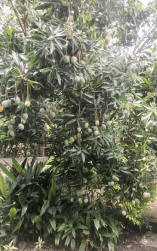While Homa farming has been found to yield excellent and sometimes amazing results, not everyone can maintain a full Homa farm; a number of disciplines must be observed, and at least several people are usually needed to meet the requirements. However, home gardeners have experienced wonderful results when Agnihotra and other Homa fires are done in or near their gardens. –Ed.

Sta. Martha, Magdalena
Colombia, South America
The mango harvest season here usually runs April–September, with a second cycle from December–March. This year, yields in the surrounding area were quite poor. Yet our mango tree benefited from daily Agnihotra at sunrise and sunset, plus regular Tryambakam Homa. Ash from the fires is also applied to nearby trees and ornamental plants. The result? A mango tree so full of fruit that its branches bend to the ground. The harvest is abundant and uniform, and the sugar mangoes are exquisite.


I would also like to share a technique: if we place water near where Homa fires are practiced, that water becomes highly healing. When combined with Agnihotra ash and then consumed by people, plants, or animals, it accelerates the healing process. OM SHREE.

Cuenca, Ecuador, South America
I have been an Agnihotri for 12 years. Since moving into my current home about 18 months ago, I built a mini-garden of just 3.5 × 3.5 meters (~10 m²). With regular Homa fires, there is always something to harvest. Results have been remarkable: Swiss chard produces giant, tasty leaves; zucchini plants continue to fruit heavily even past their natural cycle; and all plants thrive with the energy of the fires and the application of sieved Agnihotra ash.



At 2500m altitude, I cultivate kale, lettuces, chives, coriander, parsley, zucchini, Swiss chard, beets, celery, dandelion, and medicinal herbs like mint and nettle. Some herbs are also used in plant-based cosmetics, my profession. Flowers such as lavender, sunflowers, and ataco also thrive. In such a small space, the Homa fires make it possible to grow food and medicine sustainably.
I maintain a compost system where kitchen scraps and garden waste are layered with soil and Agnihotra ash. It stays clean, odor-free, and produces rich compost for continued planting.
(It is recommended to spread Agnihotra ash on soil during planting and transplanting. Ash from Om Tryambakam and Vyahruti Homa may be used on existing plants, lawns, and larger areas. –Ed.)

